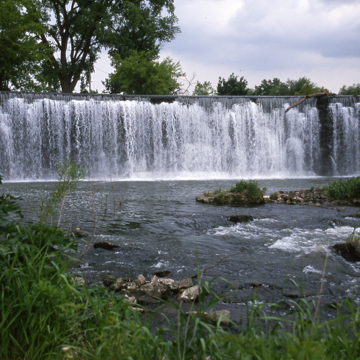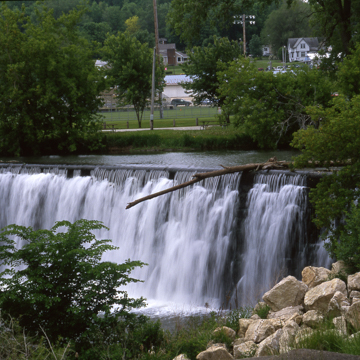Completed in 1868, the Lanesboro Stone Dam was erected by the Lanesboro Townsite Company. The town’s founders, some of whom were investors in the Southern Minnesota Railroad Company, envisioned Lanesboro as a milling center, with wheat from the surrounding region milled in town and shipped east via the Southern Minnesota Railroad. The planned community’s prosperity hinged on the construction of a dam across the south branch of the Root River that would funnel water into a diversion canal to power the flour mills.
The first dam built by the Lanesboro Townsite Company was a gravity dam, formed of several stone tiers that resembled a stairway, with each tier set back from the one immediately below. A gravity dam is so heavy that the hydrostatic load (water pressure) cannot move it. But the design proved inadequate and the river soon pushed through it. The Lanesboro Townsite Company hired Irish immigrant Dennis Galligan to engineer a new dam. At the time, Galligan was also erecting buildings in Lanesboro, including the Galligan Block, an impressive two-story commercial building, and an opera house, one of the earliest cultural hubs in town.
Galligan erected an arch dam using locally quarried stone. A more elegant design than the gravity dam, an arch dam does not rely on weight to resist hydrostatic loads but on “arch action.” Pressure against the upstream face of the arch is carried through the arch and to the abutments at either end of the dam. Because of the arch’s shape (an arc curving upstream), the shear and bending forces pushing against it are minimized. Designing an arch dam to withstand a particular hydrostatic load is more technically demanding than designing a gravity dam. It is somewhat surprising that this nascent community mustered the expertise to complete such a complicated structure, yet the 193-foot-long, 25-foot-high dam has stood for nearly 150 years, validating the skill of those who built it. In fact, Galligan went on to become a railroad engineer, making a name for himself in the Upper Midwest and Canada.
Unfortunately, Lanesboro’s dream to become a southern Minnesota milling center was mostly quashed by the turn of the twentieth century. Wheat farming had so depleted the soil in the region that little of that crop type could grow. In fact, the two-mile-long, one-mile-wide lake created by construction of the $15,000 dam largely had filled in by this time as a result of soil runoff. The three mills along Lanesboro’s diversion canal closed. The collapse of the wheat industry in Lanesboro did not mean the end for the dam and diversion canal, however, and both remained vital to the community. In 1895 the town built a hydroelectric plant. Water directed into the diversion canal by the dam now fed into turbines at the hydroelectric plant, spinning them to generate electricity for the town’s residents. The plant was rebuilt in the 1920s.
Today Lanesboro’s dam continues to channel water into the diversion canal to generate electricity, although much of the river’s flow spills over the dam’s crest, creating a picturesque waterfall. The dam has become the defining symbol of Lanesboro and stands as one of the oldest stone arch dams in the country.
References
Gardner, Denis P. Minnesota Treasures: Stories Behind the State’s Historic Places. St. Paul: Minnesota Historical Society Press, 2004.
Frame, Robert M., “Lanesboro Historic District,” Fillmore County, Minnesota. National Register of Historic Places Inventory-Nomination Form, 1982. National Park Service, U.S. Department of the Interior, Washington, D.C.



















